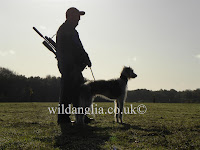Poison and peril? Well, the Fall's other crop bursts forth now in all its various guises. This is fungi time .. when the spores become polypores. The brackets, the toadstools, the mushrooms, the puffballs .. in so many shapes and sizes. Living organisms of great beauty or ugly fascination, so often passed by. Next time you see a display of fungus .. in any form .. stop and study it for a moment. Consider the miracle of nature that allowed its design and its purpose. If I consider any of my outdoor time 'inept' it is in not being able to remember the names of all but the most common of these wonderful organisms. A cardinal sin and one I hope to repair before I get too much older. For among these fungi is a rich source of foragers food which I have never had the confidence to harvest. And true wild harvest it is.
The game shooter is abroad, grinning from ear to ear and trying to keep the over-eager cocker at heel. A lucky sort will have already enjoyed a month at the Frenchmen or our own Grey partridges .. yet would have been cleaning the barrels with vigour on the last day of September ready for the high birds and the drawn cover. Ready for the captains lecture, the peg-draw, the shooting lunch, the sloe gin, the brace for the larder .. and hopefully the beaters tip. The sharper shooters will have a design on that prized right and left (or a pin-tail for the cap) from that rocket of a bird .. the woodcock. I step near these avian ninjas so often on my permissions and admire any gun that could achieve a pair, such is their speed. Out near the water-margins those hardy fowl-gunners are now crouching in dawns first glimmer with ears cocked to the breeze listening for the whistling and piping and honking of incoming opportunity. Skeins of Pinkfoot and Greylag pepper the horizon of my beloved Broadland and fill the morning sky with pattern and sound. The harder the weather, the greater the prize. Fair meat, hard won. True, true hunting .. where terrain, time, tide and elements give the quarry more than fair law.
Around me in the forest, the stalkers are trying to tidy up on the roebucks before the winter purdah prevails and they turn their attention to the does. The creeping muntjac will, of course, remain fair game all year and keep the freezer topped up. So as the high pheasant flies overhead and I follow it in mockery of the shotgun shooter with my barrel, giving lead and whispering 'bang' .. don't think I'm unhappy. When the teal whistle down the twilight dyke and I pretend, with my airgun, that I am punt-gunning with a four-bore .. trust me, they fell stone dead. When I'm hunkered at the woods edge, after a magpie chasing crane flies on the pasture, and a roebuck steps into the clearing just twenty yards away? I may, just may .. place my crosshair on it's heart with my safety catch engaged and imagine 'boom!'. Yet, consider this. I could do all this. Nothing impedes me. I simply choose not to .. for now.
Not for me, though, any of the above. As dawns swirling mists dampen the floor I will be patrolling the wood and field margin with my humble little popgun and enjoying my sport largely unseen and unheard. No slapping of hands or crossing of palms. No 'seasons'. I will perhaps lay a net along the woods edge near the stubbles and float out a decoy or two .. for I love a wood-pigeon breast or two in my Sunday hotpot. I will be trimming out those little nest-pirates, the grey squirrels, with a vengeance this year for they have robbed me blind. Yes .. blind I may have well been for not ever seeing a red squirrel in the flesh. I have always had a solid purpose for culling greys, in pursuit of songbird protection. Now, however, having seen those little red pixies dancing on the boughs in Cumbria I am massively jealous and hold the loss of the red squirrel to Norfolk directly accountable to the grey. Who knows, I might even eat grey squirrel for the first time this Fall? If I like the taste, then it's definitely in trouble around here. The rats will be heading back from hedgerow to farm now and will need my attention. The airgun, with a red-filtered lamp on top, is the perfect antidote to a rodent attack on a grain store .. and good sport too. And the rabbits. Always the rabbits. Recovering now from last years dearth and little myxomatosis about. As the foliage retreats, dawn and dusk move closer together, so the opportunities to fill the freezer increase.
copyright Ian Barnett Oct 2013
.JPG)






































.jpg)


.jpg)
.jpg)

.jpg)

.JPG)






